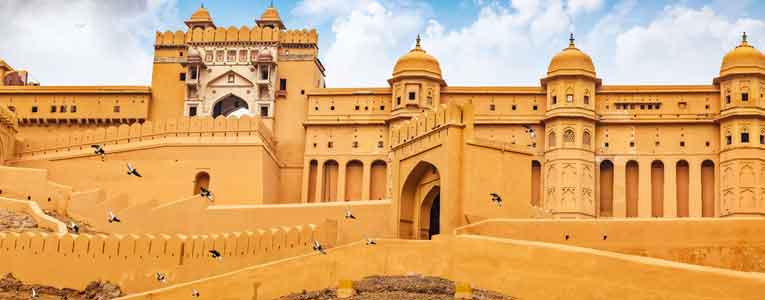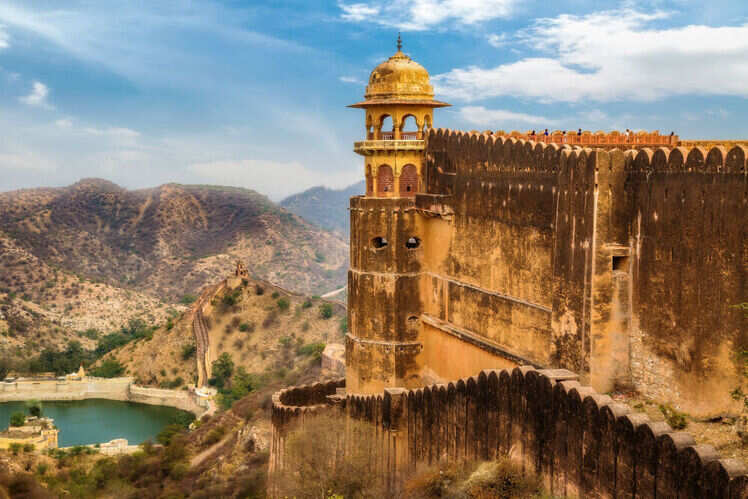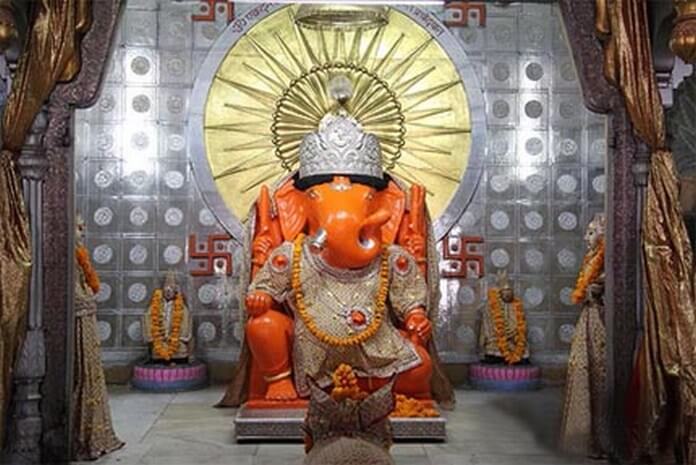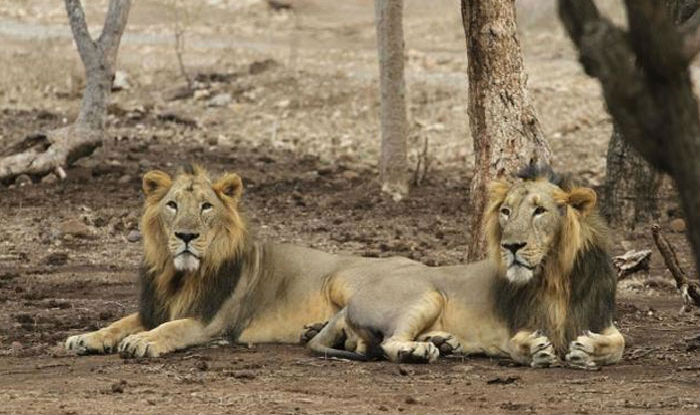Jaipur City Tour Packages : -
Jaipur is the capital of India’s Rajasthan state. It evokes the royal family that once ruled the region and that, in 1727, founded what is now called the Old City, or “Pink City” for its trademark building color. At the center of its stately street grid (notable in India) stands the opulent, colonnaded City Palace complex. With gardens, courtyards and museums, part of it is still a royal residence
Amber Fort - Amber (pronounced Amer) is at a distance of about 11 kilometres from Jaipur. Now a UNESCO World Heritage Site, it was the bastion of the Kachwahas of Amber, until the capital was moved to the plains, to what is today Jaipur. The palace, located in craggy hills, is a beautiful melange of Hindu and Mughal styles. Raja Man Singh I began construction in 1592 and the palace, which was built as a strong, safe haven against attacking enemies, was completed by Mirza Raja Jai Singh. The contrast between the harsh exterior and the inviting interior couldn’t be more surprising. Made entirely of red sandstone and white marble, visitors are left spellbound by the magnificence of the palace that utilises carvings, precious stones and mirrors. The splendour of the palace is enhanced by the breath-taking vista of the Maota Lake in front. The palace is nearly seven centuries old and has a legendary past. Originally a small structure that the Rajputs won from the Meena tribes, it was later transformed into the grand Amber Palace.

City Palace - Located deep within the walled city, the City Palace Complex was conceived and built by Maharaja Sawai Jai Singh II, the founder of Jaipur. A beautiful fusion of Mughal and Rajput architecture, the palace is still home to the last ruling royal family which lives in a private section of the palace. Maharaja Sawai Jai Singh II is credited with building most of the structures, but it was expanded upon by later rulers as well. The City Palace Complex includes the Mubarak Mahal (the palace of reception) and the Maharani’s Palace (the palace of the queen). Mubarak Mahal now houses the Maharaja Sawai Man Singh II Museum and displays a vast and unique collection of royal costumes, delicate Pashmina (Kashmiri) shawls, Benaras silk saris, and other dresses with Sanganeri prints and folk embroidery. The clothes of Maharaja Sawai Madho Singh I are also on display. The Maharani's Palace, surprisingly, has an interesting display of very well-preserved Rajput weaponry, some dating back to the 15th century. Other than the arms, the palace is adorned with beautiful paintings on the ceiling that are well-maintained.
Nahargarh Fort -Nahargarh Fort sits proudly on a ridge of the Aravalli Hills, creating an impressive northern backdrop to the city of Jaipur. It was constructed during the reign of Jai Singh in 1734, and was later expanded in 1868. Nahargarh, which means abode of tigers, was a formidable barrier, defending Jaipur against attacking enemies. Within its walls, the fort houses Madhavendra Bhawan, the summer destination for the members of the royal family. Built by Sawai Madho Singh, the palace has 12 matching boudoirs for the queens, at the head of which is a suite for the king. They are all connected by corridors decorated with delicate murals. Even today the palace is a favoured spot for local picnickers. The fort looks brilliant when floodlit at night. Overlooking the city, it presents a glittering view of the city lights.
Jaigarh Fort - About 15 kilometres from Jaipur, Jaigarh Fort was built by Sawai Jai Singh II sometime in the early 18th century amidst the arid, rocky and thorn-scrub covered hills. Despite its ancient construction, it still retains most of its imposing citadel appearance. Visitors can see the world’s largest cannon – Jaiban, at the fort.

Birla Mandir -The Lakshmi-Narayan Temple, or the Birla Temple, as it is more popularly known as, is located at the base of Moti Dungari. Built on an elevated platform, this comparatively modern temple is built entirely of white marble and dominates the skyline of south Jaipur. The temple was commissioned and built by renowned Indian industrialists, the Birlas, in 1988. The temple is dedicated to Lord Vishnu, also called Narayan, and his companion, Lakshmi, the Goddess of wealth and good fortune. The temple is a work of art and has a marvellous display of exquisite carvings and sculptures covering many mythological themes. The eye is drawn to the images of Laxmi and Narayan, carved as they are, from one piece of marble. The top of the temple has three domes, each representing the three religions followed in India. This is designed to pay homage to secular India. The temple looks spectacular at night when it is lit up. Other than the main temple, the complex has a museum that exhibits the earlier belongings of the Birla family.
Jal Mahal - One of the most wonderful sights in Jaipur is the beautiful Jal Mahal or Lake Palace. The light, sand coloured stone walls and the deep blue of the water make for a wonderful contrast. The palace appears to float in the centre of Man Sagar Lake, where its magnificent exteriors can be enjoyed by tourists.
Gaitore Jaipur - Gaitore, one of the most prominent tourist attractions in Jaipur, is a royal cremation ground for the Kachwaha Rajput kings and the members of the royal family. The word 'Gaitore' is believed to be a mispronounced form of the Hindi phrase, 'Gaye ka Thor' which means 'resting place of the departed souls'. Located on a narrow valley on Jaipur-Amer road, this place is 15 km away from Jaipur. The valley has cenotaphs (chhatri) made of marble and sandstone with Rajastani carvings, dedicated to legendary kings who ruled Jaipur. A perfect blending of Islamic and Hindu temple architecture, Gaitore has cenotaphs of Sawai Ram Singh, Sawai Madho Singh and Maharaja Sawai Jai Singh II and so on. Among these kings, the cenotaph of Maharaja Sawai Jai Singh II is quite impressive with its intricate peacock carvings and designs on beautiful white marble structure. It is said that the carvings on each cenotaph reflects the taste of the respective king. Read further to know more about Gaitore and its historic significance.
Sisodia Rani Palace and Garden – Sisodia Rani Palace and Garden is located 8 kilometres from Jaipur on the Agra road. Laid out in Mughal style, it is painted with the legends of Radha and Krishna. The garden is multi-tiered and has fountains, water courses and painted pavilions. Maharaja Sawai Jai Singh II built it for his Sisodia queen.
Govind Dev Ji Temple – The Krishna temple is a rare spire-less temple and houses the idol of Govind Devji that Sawai Jai Singh brought from Vrindavan. The deity, worshipped by the erstwhile royal family, is also revered by the the locals in the area.
Moti Dungri Ganesh Temple –Moti Doongri is a small hill around which the city of Jaipur flourishes. Moti Doongri means pearl hill, because the hill indeed resembles a pearl drop. Visitors go there to pay homage at the famous Ganesh temple, the most auspicious and important religious temple in Jaipur. The Ganesh temple was built by Seth Jai Ram Paliwal, sometime in the early 18th century. A legend goes, the King of Mewar was heading back to his palace after a long journey and was carting a massive Ganesh idol on a bullock cart. The king had decided that he would build a temple for the idol of Lord Ganesh wherever the bullock cart stopped. Apparently the cart stopped at the foot of the Moti Doongri, which is where the temple is situated today. The hill also has an exotic palace perched right on top. A replica of a Scottish castle, it was once the royal home of Maharaja Sawai Man Singh. It continues to belong to the royal family. The mere view of this castle is extremely exotic.

Digamber Jain Mandir – The ancient Digambar Jain temple at Jaipur is in Sanganer, 14 km from the city. The principal idol in the Sanghiji Temple is of Lord Adinath in the Padmasan (lotus position) posture. The temple is made of red stone and has attractive carvings. The seven-storied temple has sky-high 'shikharas' (spires) and its inner sanctum is a stone shrine with eight sky-high shikharas.
Jantar Mantar -Now a UNESCO World Heritage Site, Jantar Mantar in Jaipur is considered to be the largest of the five astronomical observatories built by Maharaja Sawai Jai Singh II, the founder of Jaipur. It contains sixteen geometric devices, designed to measure time, track celestial bodies and observe the orbits of the planets around the sun. It also houses the Interpretation Centre that helps the tourists to understand about the working principles & chronolgy of the observatory.
Hawa Mahal - Hawa Mahal, literally the Palace of Winds, was built in 1799 by the poet king Sawai Pratap Singh as a summer retreat for him and his family. It also served as a place where the ladies of the royal household could observe everyday life without being seen themselves. This unique five-storey structure is a blend of Hindu and Islamic architecture, and the exterior, with its small latticed windows (called jharokhas), resembles the crown of Lord Krishna. The windows also serve as an air-conditioner of sorts, blowing cool air throughout the palace, making it the perfect retreat during summers. Built from pink sandstone, the Hawa Mahal is Jaipur’s iconic landmark and visitors can view its complete magnificence from outside, from across the road. However, it is also possible to climb right up to the top for a wonderful view from the windows. Today, the Mahal is maintained by the Archaeological Department of the Government of Rajasthan and also houses an archaeological museum in the courtyard.

Albert Hall Museum - The building gets its name from The Victoria and Albert Museum in London, the inspiration for its design. The exquisitely built Albert Hall is housed in the centre of Ram Niwas Garden. Sir Swinton Jacob (who is also the mastermind behind many other palaces in Rajasthan) conceptualised and designed it using styles from the Indo-Sarcenic architecture and the Prince of Wales laid the foundation stone of the building in 1876. The museum displays a wide range of metal objects, wood crafts, carpets, stone and metal sculptures, arms and weapons, natural stones and ivory goods. It also houses a large collection of miniatures from Bundi, Kota, Kishangarh, Udaipur and Jaipur schools of art.
Galtaji Temple – Galtaji is an ancient pilgrimage centre in Jaipur. Set amidst low hills and packed with locals and tourists alike, the attractive spot has temples, pavilions and holy kunds (natural springs and water tanks). Visitors to Galtaji will come across the complex of Ramgopalji temple, locally called the Monkey temple (Galwar Bagh). It gets this moniker because of a large group of resident monkeys. The green landscape and chattering monkeys add to the delight of the area. On top of the hill is a small temple dedicated to the sun god, called the Surya Mandir. Constructed by Diwan Kriparam, the temple can be seen from anywhere in the city.
Nahargarh Biological Park – Nahargarh Biological Park, a part of the Nahargarh sanctuary is located about 12 km from Jaipur on the Jaipur-Delhi highway. It encompasses a large area of 720 hectares and is situated under the Aravalli range. The Park is famous for its vast flora and fauna, and its main aim is to conserve it. It also doubles up as a great place to educate people and conduct research on existing flora and fauna. At Nahargarh Biological Park, ornithologists can expect to see over 285 species of birds, of which, the most popular is the white-naped tit, which can only be found here. When you visit the Park, make sure you also head to Ram Sagar, which is a famous among bird watchers and makes for a great spot to catch different varieties of birds. While here, you can stay at well-equipped and famous places such as Ganga Vilas, Gopal Vilas and Lalit Vilas, which were famous with the maharajas of the yore as hunting lodges. The Nahargarh Zoological Park is also worth a visit and houses animals such as Asiatic lions, Bengal tigers, panthers, hyenas, wolves, deer, crocodiles, sloth bear, Himalayan black bear, wild boar, etc.

Incredible India
India Tourism
Jaipur Attractions
India Tour Packages
Luxury Tour Packages
No comments:
Post a Comment